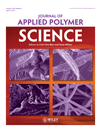Relating scratch resistance to injection molding-induced morphology of polypropylene
Abstract
The relationship between the scratch resistance and the injection molding-induced morphology of polypropylene (PP) was investigated. The crystal structure near the surface was controlled by the mold temperature and the doping of a nucleating agent (NA). Although α- and β-NA were used to improve the scratch resistance of PP that was molded at a mold temperature of 40°C, both of the NAs only slightly affected the scratch resistance due to low crystallinity at the surface. When the mold temperature was increased, the skin layer became thin and a β-form crystal formed. Plastic deformation under the scratch was limited in the frozen layer. Consequently, the thickness of the frozen layer (which had low crystallinity) had the predominant effect on the scratch resistance in comparison to the polymorphism differences. The crystal morphology was analyzed with synchrotron micro-beam wide angle X-ray diffraction and Fourier transform infrared spectroscopy. © 2010 Wiley Periodicals, Inc. J Appl Polym Sci, 2011




